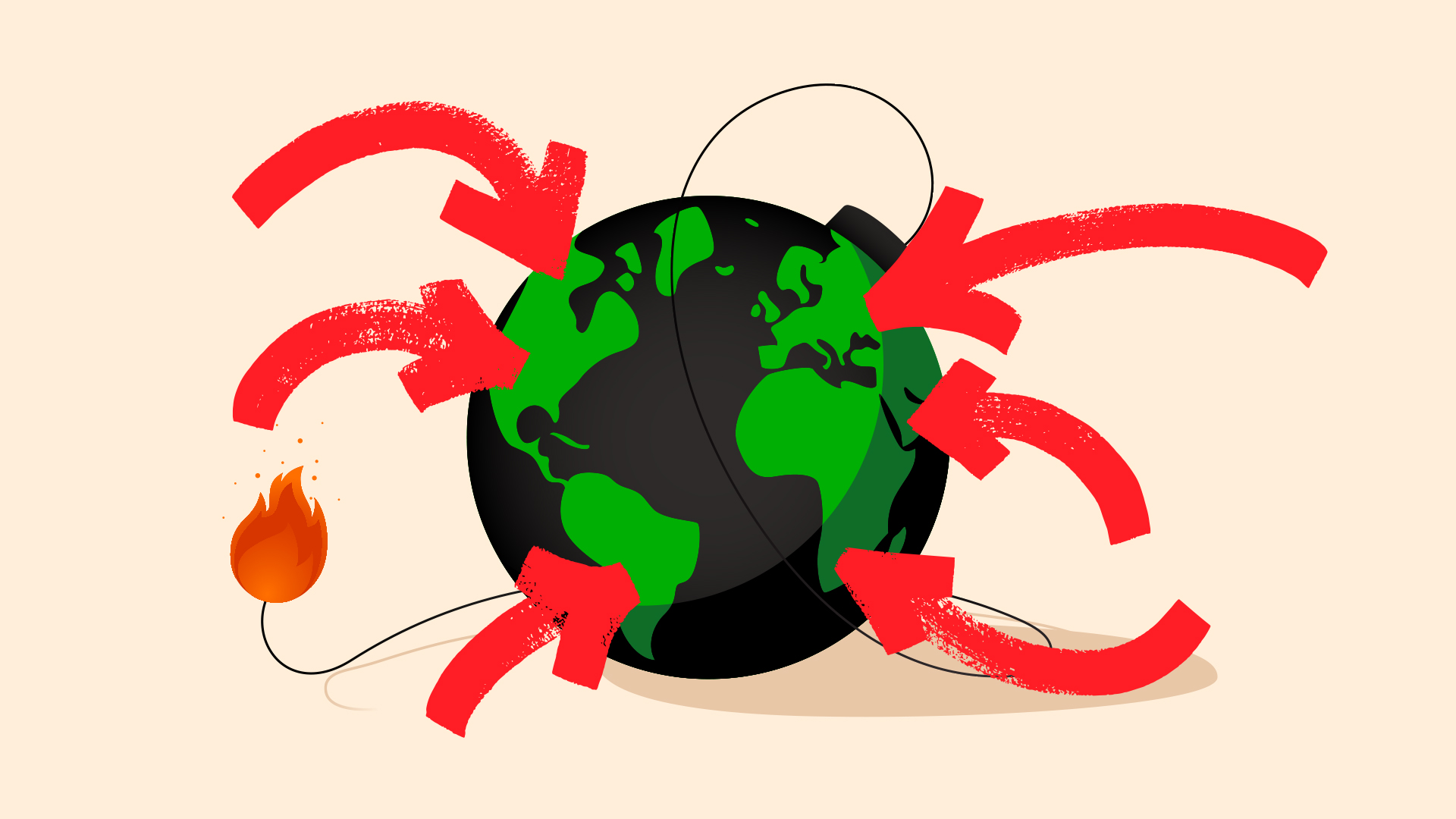“Polycrisis” is a word that has recently come into use to characterize the way crises in many different spheres – ranging from geopolitics and economics to climate and pandemic – are aggravating each other and even converging. This commentary, the second in a series on “The Polycrisis and the Global Green New Deal,” gives an overview of polycrisis dynamics. Subsequent commentaries in this series will look at some of these dynamics in greater depth and at how the polycrisis can be addressed by the development of a global insurgency and a multi-level Green New Deal.

“Polycrisis” is a buzzword, but one that, like “globalization” a few decades ago, captures something important about what is going on in the world. Crises can no longer be understood as crises “in” international relations, economics, governance, or climate. Rather, the crises in these different spheres are increasingly aspects of the polycrisis.
The key concept for the polycrisis is interaction. It cannot be understood by simple cause-and-effect models within a single sector or even within the world order as a whole. The interaction of forces, acts, and events determines its patterns and its course.
There are many dynamics operating within the polycrisis; this commentary focuses on some of the most important ones. Obviously, others could be listed as well – and still others are likely to emerge as the polycrisis proceeds. However, these should be enough to show why no single aspect of the crisis in the world order can be understood, let alone addressed, without regard to the others.
There are contradictory tendencies both within and among these dynamics. For example, there is a fracturing of globalization but at the same time continued growth in world trade and the concentration of global economic power. Such contradictions make it of limited value to extrapolate these polycrisis dynamics into longer-term trends, other than the probability of increasing conflict and chaos.
I will sometimes use categories like geopolitics, deglobalization, governance, and climate. These are meant merely as categories of convenience. They are simply loose groupings of loosely related phenomena. They are not intended as analytical categories for understanding the polycrisis. On the contrary, the polycrisis is defined by the extent to which its dynamics cross all such categories.
Many topics will reemerge repeatedly both in this Commentary and throughout this series. That is a necessary consequence of the intertwined, interactive character of the polycrisis. Here is a synopsis of some of them.
Unleashed warfare: The past two years have seen more violent conflict than at any time since the end of World War II, according to the Uppsala conflict data program.[1] Great power rivalry has rapidly moved from a period of relative détente and unipolar US dominance, through the rising tensions of “the new cold war,” to direct military engagement with great power surrogates in Ukraine, the Asian Pacific, and the Middle East. The three great powers, China, Russia, and the US, are cajoling and bribing lesser countries to join their blocs. Lesser countries are resisting, trying to support each other in that resistance, playing off great powers against each other, and trying to make a cafeteria of alliances with different powers in different arenas. The whole dynamic has the eerie appearance of choosing up sides for World War III.
Vicious circles of conflict: While great powers may perceive their own actions, such as augmenting preparation for war, as defensive, they are often perceived by their opponents as aggressive and threatening. They may therefore be met with actions that further escalate conflict. The result is an interactive “vicious circle” of escalation. This process can often lead to results that are intended by nobody but that have devastating consequences for the protagonists as well as for bystanders – World War I is often held up as a classic example. The current arms race and expansion of weapons production is another obvious example. Threats to use nuclear weapons from officials in Russia and Israel, along with the termination of the Nuclear Test Ban Treaty — the cornerstone of the transition from the Cold War to an international arms control regime – indicate where such uncontrolled escalating conflict is headed. The cycle of escalation can be seen in the threat by France that NATO troops might be sent to Ukraine, followed by Russia’s counter-threat that NATO troops in Ukraine would mean war with Russia with a high risk of nuclear war that would destroy Europe.
Breakdown of international cooperation: The world’s great problems can only be addressed through international cooperation. Such cooperation has never been strong but it has been real, operating through the various branches of the United Nations, through cooperation among governments, and through international organizations of many kinds. But even this weak cooperation has been undermined by the predominance of geopolitics and other aspects of the polycrisis. This is evident in the arena of security, where periodic attempts at international cooperation have been blocked by the ambitions of the great powers. It is obvious in the failure of international cooperation to protect the earth’s climate. It is apparent in the decline of economic cooperation and the rise of economic nationalism and rival blocs. It is clear in the failure of global public health cooperation in the face of the COVID pandemic and the weakness of subsequent cooperation to prevent or contain future pandemics. And it is revealed in the failure to control the widely recognized threats of new technologies, such as nanotechnology, drones, and Artificial Intelligence.
Thucydides trap: At the end of the Cold War the US had its “unipolar moment” of global hegemony, but now faces economic, political, and military challenges from countries around the world. While no power currently seeks to replace the US as global hegemon, many countries and regions are resisting the efforts of the US to control them. In a pattern well-known in history and often characterized as the “Thucydides trap,” the rising wealth and power of China is coming into conflict with the desire of a hegemonic United States to maintain its global dominance. The polycrisis is greatly aggravated by the US belief that the loss of US domination is the cause of the polycrisis and that restoring unipolarity and global domination is both feasible and the key to overcoming the polycrisis. In reality, no increase in US geopolitical and military power is likely to contain let alone reverse the polycrisis. Conversely, there is little reason to believe the polycrisis can be resolved simply by weakening US power and replacing it with a polycentric world order of less great but still self-aggrandizing states.
War crime wave: Mass atrocity violence has grown rapidly, due to the proliferation of wars, the support by the geopolitically motivated great powers for their own and their allies’ war crimes, and the abandonment of UN and other international implementations of the “duty to protect.” The killing of 1,200 Israelis, followed by the killing of more than 36,000 (and counting) Palestinians. These war crimes followed the mass killing of civilians in Syria and Ukraine, the internment of one million Uyghurs and other Muslims in China, war crimes in Ethiopia, ethnic cleansing in Sudan’s Darfur province, and the displacement of two million Rohingya and other Muslims in Myanmar. Kate Ferguson of the NGO Protection Approaches says, “We face the likelihood that this violence is going to characterize the next political era. In fact, I wonder if we’re not already in that era.”[2]
Fragmented globalization: For the four decades after 1980 a process of economic globalization increasingly integrated the global economy. Soviet, Chinese, and US trade blocs largely dissolved. Companies moved production around the globe to wherever labor, environmental, and other costs were lowest. Production developed into a transnational “global assembly line.” Huge financial flows raced around the globe – often producing global financial crises. International trade agreements and institutions like NAFTA and the World Trade Organization moved the world toward a single little-regulated market. But, largely as a result of growing economic nationalism and burgeoning great power conflict, economic warfare has broken out among the great powers. The US is trying to hobble Chinese economic development, for example by its “chip war” intended to prevent China from accessing advanced computer chip technology. In the context of the Ukraine war, the EU and Russia have battled over energy trade. US industrial policy to subsidize “green” production in the US has been seen in Europe as the opening of a trade war to make European clean energy goods uncompetitive in the US market. While this process is sometimes described as “deglobalization,” in fact transnational economic activity continues to grow, but in the form of a struggle to control fragmented transnational economic networks.

“Deglobalization” is not, however, leading to a restoration of the integrated national economies that preceded the era of globalization; in 2023 goods traded across borders reached an all-time high.[3] Rather, deglobalization is leading to bullying designed to line up countries in support of one or another superpower. For example, US semiconductor companies, at the instigation of the US government, recently coerced a Persian Gulf technology company to break off cooperation with Chinese manufacturers. While such coercive “friendshoring” could potentially lead to the re-emergence of trade blocs, at present it is creating more of an economic war of all against all. Lesser countries and businesses seek to “mix and match” their allegiances, but they meet heavy pressure to choose up sides.
Geopolitics trumps all: Deglobalization is part of a broader trend: the subsumption of the economic and indeed all else to the geopolitical conflict of the great powers. The slogan of the Clinton era, “It’s the economy, stupid!” is being reversed to read “It’s the enemy, stupid!” Whether in trade, health, energy, or political alliances, geopolitical “necessities” are increasingly overriding all other public, and even private, interests.
Inequality: The dynamics of plutocratic policymaking, crony capitalism, deregulation, detaxation, and subsidy of fossil fuels and the wealthy are driving more extreme inequality. Despite the fragmentation of globalization, global concentration and centralization of capital continue apace; consider, for example, Nippon’s pending purchase of U.S. Steel. Since 1995, the share of global wealth possessed by billionaires has tripled, from 1% to over 3%; 2020 marked the steepest increase in global billionaires’ share of wealth on record. The share of wealth of the global top 0.01% rose from 7% in 1995 to 11% in 2021. Over the past two decades the gap between the average incomes of the top 10% and the bottom 50% of individuals within countries has almost doubled. The share of income presently captured by the poorest half of the world’s people is about half what it was 200 years ago. The poorest half of the world’s people own just 2% of total wealth, while the richest 10% of the global population own 76%.[4]
Democracy deficit: Ostensibly most of the world’s governments are in some sense democracies. The great majority of them hold some kind of elections that purportedly select their national leaders. Historically the extent to which ordinary people have been able to influence the actions of their governments has varied from country to country and from time to time. However, everywhere at all times it has been quite limited, even in the most “democratic” countries. The ability of ordinary people to make governments serve their interests and wishes has sharply diminished throughout the world. The dominance of neoliberal practice has delegitimated action by government to serve public purposes. The capacity of governments to shape social realities has declined in tandem. With the worldwide concentration of wealth and the power it provides, most governments have moved closer to what can be described without exaggeration as plutocracies, in which actual power resides with a tiny minority of wealthy individuals and organizations. The inability of government to provide benefits for ordinary people has led to deep popular alienation from the institutions of government and politics. At the supranational level, there is little if any institutionalized opportunity for ordinary people to affect global governance and the world order.
Rise of fascist and para-fascist movements: Extreme right and fascist movements have arisen in many places around the world and have won governing authority or participation in governing coalitions in Argentina, Italy, Poland, Sweden, Finland, Russia, India, and Israel – not to mention the once and perhaps future President Donald Trump in the US. While these movements vary somewhat from country to country, they have strong common themes, including fear of and hostility toward immigrants; anti-feminism, homophobia and transphobia; and a backlash against perceived progressive social change, such as the now worldwide “war on woke.”[5] All scorn democratic principles; encourage violence; scapegoat disempowered social groups; follow charismatic leaders; and whip up a mass base.[6] These movements are linking up through international organizations and networks and are providing each other support.
Climate crisis: The last months of 2023 were the hottest in 125,000 years. Global warming is causing heat waves, disease outbreaks, floods, droughts, and melting of Arctic and Antarctic ice caps. The longer-term business-as-usual structure of the world order, with its nation-state rivalry, great power dominance, drive for unlimited capital accumulation, domination of governments by fossil fuel interests and the wealthy, and pathetically inadequate capacity to represent global human interests, has been more than adequate to promote the continuation and expansion of fossil fuel extraction and burning. But the polycrisis is aggravating the climate crisis and making it more intractable. For example, after Russia’s 2022 invasion of Ukraine, government financing for fossil fuels increased sharply and subsidies almost doubled from 2020 rates.[7] Meanwhile, the climate crisis is aggravating other aspects of the polycrisis. Drought in Panama, for example, has cut the number of ships that can go through the Panama Canal by half, aggravating supply chain pressures and therefore inflation.[8] Desertification has forced mass migration, which in turn has provided fodder for anti-immigrant fascist and para-fascist movements in the US, Europe, and elsewhere. The earth has recently passed a number of irreversible climate “tipping points” that will guarantee additional global warming even if fossil fuel burning is reduced.
Incoherence: In the complex, contradictory, chaotic world of the polycrisis, apparent trends and tendencies conflict. In that context, policies of nation states and other actors are likely to be incoherent and even self-contradictory, producing unintended side effects far different from their intent. For example, US interest in a two-state solution in Palestine has been combined with unwavering support for an Israel that has said it will oppose a two-state solution under all conditions. A purported commitment to reducing greenhouse gas emissions has been combined with a licensing of huge fossil fuel extraction projects in Alaska and the Gulf South.
Unpredictability: The polycrisis as a whole and the interaction of its different elements make rational anticipation of future developments extremely difficult. Consider the unanticipated eruption of the COVID pandemic; the outbreak of the Russia-Ukraine war; and the war and genocide in Gaza. The subsidies and trade barriers the US erected to block import of “green” goods from China also caused disruption in the economies of its European allies. European restrictions on Russian fossil fuel exports led to a boom in Russian energy sales in the rest of the world. US support for Israeli genocide in Gaza led to unanticipated attacks in the Red Sea by the Houthi.
While all these examples could to some extent have been predicted, they were no more certain than many other events that were just as reasonably predicted, but that did not in fact transpire. In 2023 escalating conflict between the US and China over Taiwan and massive currency defaults were both widely predicted, for example, but did not transpire. The policies of Donald Trump during his presidency were so self-contradictory and erratic that efforts at predicting them would have been absurd; the same applies to a possible future Trump presidency. (Such wild shifts and inexplicabilities have been normal in past fascist regimes.) Perhaps the only thing that can be confidently predicted in the polycrisis is the likelihood of intensified unpredictability.
Decline of social learning: Governments and societies can learn from the feedback from their actions. After the devastation of the Great Depression, countries around the world adopted financial regulation and Keynesian budgetary policies to stabilize the growth of their economies. After coming to the verge of nuclear holocaust in the Cuban Missile Crisis, US President John Kennedy backed away from Cold War belligerence and moved toward advocating a form of common security; the US and the Soviet Union began moving toward détente and arms control. After the string of financial crises that culminated in the Great Recession, many developing countries began accumulating financial reserves to protect against currency crises. But so far there is scant evidence of any social learning regarding the dynamics of the polycrisis. Military build-ups and aggression seem to be met with arms races and further aggression. The cascading evidence of climate catastrophe is met by doubling down on fossil fuel extraction and burning. No feedback loops seem to connect these actual results to the actors and actions that could correct their causes.
The folly factor: Perhaps the most pervasive dynamic of the polycrisis is folly. Rational pursuit of self-interest has become increasingly scarce in the polycrisis. This is evident in the incoherent, self-contradictory, foolish behavior of powerful institutions. Governments and corporations pursue expansion of fossil fuel extraction and burning even though they have every reason to know that it will lead to their own destruction. Countries engage in military build-ups, even though they have every reason to know that they will only provoke reciprocal build-ups among their opponents, leading to augmented mutual threat. Corporations fight to dismantle financial regulation, even though experience has shown that such deregulation will lead to greater financial crashes. But it is also folly for the people of the world to acquiesce or even participate in the destruction of our world. To engage in actions every day that may be intended to provide a better life, but that in practice are destroying the very basis of wellbeing for ourselves and our progeny. To allow ourselves to be sucked along by the blandishments of the powerful.
While folly has been an abiding feature of human life, today’s polycrisis grows out of and also augments the fundamental folly that, in today’s world, self-preservation can be attained without common preservation.[9]
Fixing one or another aspects of the polycrisis is unlikely to establish stability, let alone sustainability or justice. Nor is change – even revolutionary change — in one or another nation likely to long resist the dynamics of the polycrisis. There is little reason to think that the disordering of the world order will automatically lead to socialism or some other possibly more positive alternative. But the polycrisis does foreclose some old and open some new possibilities for collective action. We will explore these in later commentaries in this series.
[1] Uppsala conflict data program, Uppsala conflict data program. See also Paul Post, “Not a World War, But a World at War,” The Atlantic, November 17, 2023 https://www.theatlantic.com/international/archive/2023/11/conflicts-around-the-world-peak/676029/#
[2] Julian Borger. “World Faces ‘Heightened Risk’ of Mass Atrocities due to Global Inaction.” The Guardian, December 8, 2023, sec. Law. https://www.theguardian.com/law/2023/dec/08/un-and-us-efforts-to-stop-mass-atrocities-have-waned-activists-warn.
[3] Tim Sahay. “A Year in Crises.” Phenomenal World. December 21, 2023. https://www.phenomenalworld.org/analysis/a-year-in-crises/.
[4] World Inequality Report. “The World #InequalityReport 2022 Presents the Most Up-To-Date & Complete Data on Inequality Worldwide”: World Inequality Report 2022. October 9, 2021. https://wir2022.wid.world/executive-summary/.
[5] Walden Bello, “Fascism 101: Why We Need to Spell It out ” 2023. Portside.org. December 22, 2023. https://portside.org/2023-12-22/fascism-101-why-we-need-spell-it-out?utm_source=portside-general&utm_medium=email
[6] Alberto Toscano, “The Rise of the Far Right Is a Global Phenomenon.” In These Times, November 21, 2023. https://inthesetimes.com/article/global-far-right-meloni-milei-putin-bannon-orban?link_id=5&can_id=1058857240102273c369153e44c89a13&source=email-escalating-settler-violence-in-the-west-bank-dont-pave-paradise-your-neighbor-the-nuke-maker&email_referrer=email_2139925&email_subject=donald-trump-makes-a-mockery-of-populism-why-workers-are-dying-from-heat.
[7] Fiona Harvey, “World behind on almost every policy required to cut carbon emissions, research finds.” The Guardian, November 14, 2023. https://www.theguardian.com/environment/2023/nov/14/world-behind-on-almost-every-policy-required-to-cut-carbon-emissions-research-finds.
[8] Jonathan Yerushalmy. “Changing Climate Casts a Shadow over the Future of the Panama Canal – and Global Trade.” The Guardian, December 22, 2023. https://www.theguardian.com/environment/2023/dec/22/changing-climate-casts-a-shadow-over-the-future-of-the-panama-canal-and-global-trade.
[9] Jeremy Brecher, Common Preservation in a Time of Mutual Destruction (Oakland, CA: PM Press, 2021). Many of the systems concepts that underlie the interpretation in this commentary are developed further in this book.

